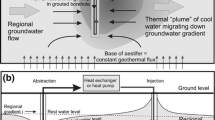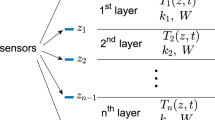Abstract
Measured groundwater temperatures in the surficial zone are dependent on the properties of porous media and vertical flow velocity. Sensitivity analyses, collinear diagnostics and an inverse numerical solution to the one-dimensional heat-transport equation are used to determine which parameters can be estimated from temperature measurements in the surficial zone. This is done for heat transport in the saturated zone considering a constant vertical flow velocity. The use of temperature profiles, temperature time-series and temperature envelopes are considered. There is an important difference between a conduction and a convection dominated system. Sensitivity analysis shows that temperature measurements are sensitive to effective thermal conductivity and heat capacity and are insensitive to effective porosity and thermal dispersivity. In a conduction dominated system, temperature is also insensitive for vertical velocity. Collinear diagnostics show that in a conduction dominated system, only the combination of heat capacity and effective thermal conductivity, the thermal diffusivity, can be derived. In a convection dominated system, both the vertical velocity and the effective thermal conductivity can, theoretically, be derived.
Résumé
La température des eaux souterraines mesurée dans la zone superficielle est dépendante des propriétés du milieu poreux et de la vitesse des flux verticaux. Les analyses de sensibilité, les diagnostics colinéaires et une solution numérique inverse à l’équation de transport de chaleur unidimensionnelle ont été utilisées pour déterminer quels paramètres peuvent être estimés à partir des mesures de température dans la zone superficielle. Ceci a été fait pour le transport de chaleur dans la zone saturée en considérant une vitesse de flux vertical constante. Les profils, séries et enveloppes de températures ont été pris en compte. Il y a une différence importante entre un système dominé par la conduction et un système dominé par la convection. L’analyse de sensibilité montre que les mesures de températures sont sensibles à la conductivité thermique efficace et à la capacité thermique et ne sont pas sensibles à la porosité efficace et la dispersivité thermique. Pour un système dominé par la conduction, la température est également insensible à la vitesse verticale. Les diagnostics colinéaires montrent que, dans un système dominé par la conduction, seule la combinaison de la capacité thermique et de la conductivité thermique efficace et la diffusivité thermique peut être déduite. Dans un système dominé par la convection, la vitesse verticale et la conductivité thermique efficace peuvent, en théorie, être obtenues.
Resumen
Las mediciones de las temperaturas en las aguas subterráneas en la zona superficial dependen de las propiedades del medio poroso y de la velocidad del flujo vertical. Se utilizaron análisis de sensibilidad, diagnósticos colineares y una solución numérica inversa a la ecuación de transporte de calor en una dimensión para determinar cuales parámetros pueden ser estimados a partir de mediciones de temperatura en la zona superficial. Esto se hizo para el transporte de calor en la zona saturada considerando una velocidad constante de flujo vertical. Se consideró el uso de perfiles de temperatura, series de temporales de temperatura y envolventes de temperatura. Existe una diferencia importante entre un sistema dominado por la conducción y uno dominado por convección. El análisis de sensibilidad muestra que las mediciones de temperatura son sensibles a la conductividad térmica efectiva y a la capacidad calorífica y son insensibles a la porosidad efectiva y a la dispersividad térmica. En un sistema dominado por la conducción, la temperatura es también insensible a la velocidad vertical. El diagnósticos colinear muestra que en un sistema dominado por la conducción, solamente puede ser deducida la difusividad térmica de la combinación de la capacidad calorífica y la conductividad térmica efectiva. En un sistema dominado por convección, tanto la velocidad vertical como la conductividad térmica, teóricamente, puede ser deducidos.
摘要
浅层地下水温测量值依赖于多孔介质的性质和垂向水流速度。对一维热传递方程进行了灵敏度分析、平行诊断和反向数值求解, 以确定浅层温度测量能够估计哪些参数。考虑恒定垂向流速下, 饱水带热传递的情景。应用了温度剖面、温度时间序列和温度包络线。传导和对流系统之间存在很大差异。灵敏度分析表明, 温度测量对有效热导率和热容敏感, 而对有效孔隙度和热分散系数不敏感。在传导为主的系统中, 温度对垂直速度也不敏感。平行诊断表明, 在传导为主的系统中, 只有综合热容和有效热导率, 热扩散系数的才可以导出。在对流为主的系统中, 理论上垂向速度和有效热导率都可导出。
Resumo
As temperaturas da água subterrânea medidas na zona superficial dependem das propriedades do meio poroso e da velocidade vertical de fluxo. A fim de determinar que parâmetros podem ser estimados a partir de medições de temperatura na zona superficial, são usadas análises de sensibilidade, diagnósticos colineares e uma solução numérica inversa para a equação unidimensional de fluxo de calor. Isto é feito para o transporte de calor na zona saturada, considerando uma velocidade de fluxo vertical constante. São consideradas as utilizações de perfis de temperatura, de séries temporais de temperatura e da envolvente térmica. Existe uma diferença importante entre sistemas dominados pela condução e pela convecção. Análises de sensibilidade mostram que as medições de temperatura são sensíveis à condutividade térmica efectiva e à capacidade térmica e são insensíveis à porosidade efectiva e à dispersividade térmica. Num sistema dominado pela condução, a temperatura é também insensível à velocidade vertical. Os diagnósticos colineares mostram que, num sistema dominado pela condução, só a combinação da capacidade térmica e da condutividade térmica efectiva, a difusividade térmica, pode ser deduzida. Num sistema dominado pela convecção, quer a velocidade vertical quer a condutividade térmica efectiva podem ser, teoricamente, deduzidas.









Similar content being viewed by others
References
Anderson MP (2005) Heat as a ground water tracer. Ground Water 43(6):951–968
Bravo HR, Feng J, Hunt RJ (2002) Using groundwater temperature data to constrain parameter estimation in a groundwater flow model of a wetland system. Water Resour Res 38(8). doi:1029/2000WR000172
Bear J (1972) Dynamics of fluids in porous media. Elsevier, New York
Belsley DA (1990) Conditioning diagnostics: collinearity and weak data in regression. Wiley, New York
Carrera J, Neuman SP (1986) Estimation of aquifer parameters under transient and steady state conditions. 1. Maximum likelihood method incorporating prior information. Water Resour Res 22(2):199–210
Constantz J, Cox MH, Su GW (2003) Comparison of heat and bromides as ground water tracers near streams. Ground Water 41(5):647–656
De Marsily G (1986) Quantitative hydrogeology. Academic, San Diego, CA
Domenico PA, Schwartz FW (1998) Physical and chemical hydrogeology, 2nd edn. Wiley, New York
Draper NR, Smith H (1981) Applied regression analysis, 2nd edn. Wiley, New York
Hill MC, Tiedeman CR (2007) Effective groundwater model calibration with analysis of data, sensitivities, predictions, and uncertainty. Wiley, Hoboken, NJ
Holzbecher E (2005) Inversion of temperature time series from near-surface porous sediments. J Geophys Eng 2:343–348
Hopmans JW, Simunek J, Bristow KL (2002) Indirect estimation of soil thermal properties and water flux using heat pulse probe measurements: geometry and dispersion effects. Water Resources Research 38(1). doi:10.1029/2000WR000071
Ingebritsen SE, Sanford WE (1998) Groundwater in geological processes. Cambridge University Press, Cambridge
Lapham WW (1989) Use of temperature profiles beneath streams to determine rates of vertical ground-water flow and vertical hydraulic conductivity. US Geol Surv Water Suppl Pap 2337
Parsons ML (1970) Groundwater thermal regime in a glacial complex. Water Resour Res 6(6):1701–1720
Rorabaugh MI (1956) Ground water in northeastern Louisville, Kentucky with reference to induced infiltration. US Geol Surv Water Suppl Pap 1360-B
Slichter CS (1905) Underflow meter used in measuring velocity and direction of movement of underground waters. US Geol Surv Water Suppl Pap 140
Silliman SE, Ramirez J, McCabe RL (1995) Quantifying downflow through creek sediments using temperature time series: one-dimensional solution incorporating measured surface temperature. J Hydrol 167(1–4):99–119
Smith L, Chapman DS (1983) On the thermal effects of groundwater flow 1: regional scale systems. J Geophys Res 88(B1):593–608
Stallman RW (1963) Computation of groundwater velocity from temperature data. US Geol Surv Water Suppl Pap 1544-H, pp 36–46
Stallman RW (1965) Steady-one dimensional fluid flow in a semi-infinite porous medium with sinusoidal surface temperature. J Geophys Res 70(12):2821–2827
Suzuki S (1960) Percolation measurements based on heat flow through soil with special reference to paddy fields. J Geophys Res 65(9):2883–2885
Taniguchi M (1985) Effects of snow cover and infiltrated meltwater on soil and groundwater temperature in and around Nagaoka city. Geogr Rev Jpn Ser A 58:370–384
Taniguchi M (1993) Evaluation of vertical groundwater fluxes and thermal properties of aquifers based on transient temperature-depth profiles. Water Resour Res 29(7):2021–2026
Vandenbohede A, Lebbe L (2009) Conservative solute versus heat transport in porous media during push-pull tests. Transp Porous Med 76:265–287
Winslow JD (1962) Effect of stream infiltration on ground water temperatures near Schenectady, N.Y. US Geol Surv Prof Pap 450-C, Article 111, pp C125–C128
Acknowledgements
AVDB is supported by the Fund for Scientific Research—Flanders (Belgium) where he is currently a postdoctoral fellow. We thank associated editor J, Fairley, D, Lopez and one anonymous reviewer for their constructive remarks and suggestions to improve the paper.
Author information
Authors and Affiliations
Corresponding author
Rights and permissions
About this article
Cite this article
Vandenbohede, A., Lebbe, L. Parameter estimation based on vertical heat transport in the surficial zone. Hydrogeol J 18, 931–943 (2010). https://doi.org/10.1007/s10040-009-0557-5
Received:
Accepted:
Published:
Issue Date:
DOI: https://doi.org/10.1007/s10040-009-0557-5




